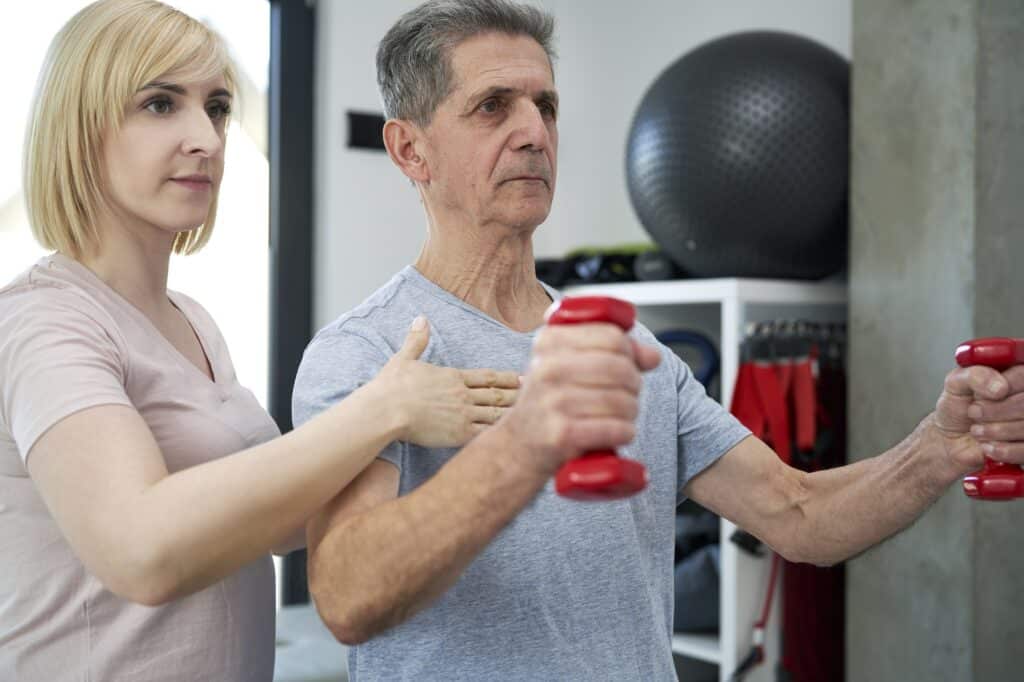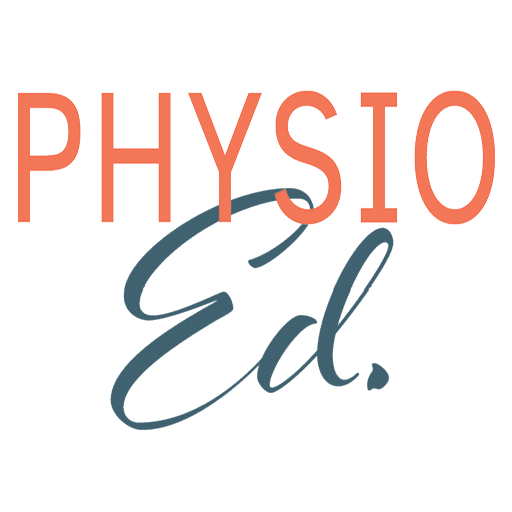Staying active is an essential part of living a healthy life. As we age, maintaining fitness and mobility can take more effort than when we were younger, and injuries may add up.
If slowing down isn’t an option, knowing which therapies can help keep you moving for the long term is essential. Physical therapy is one time-tested option that’s especially important for older adults.
Let’s look at physical therapy, its uniqueness and effectiveness, and how to choose the right physical therapist for your needs.
What is Physical Therapy?
According to the American Physical Therapy Association:
“Physical therapists are movement experts who team with physical therapist assistants to improve quality of life through hands-on care, patient education, and prescribed movement.”*
In more detail, physical therapy (or physiotherapy) is a division of health care known as rehabilitation medicine focused on treating and preventing physical injuries, disabilities, and other impairments.1
Physical therapy aims to help people regain strength and mobility and return to regular activities.
Finally, physical therapy is a non-invasive, drug-free treatment option for treating or alleviating pain and improving mobility. So, even if you need certain medications or procedures to remain active at first, a primary goal of physical therapy is to help you wean off these treatments and improve your overall comfort with activity.
What Do Physical Therapists Do?

Physical therapists are trained and qualified at a doctoral level as health care professionals, making them specially certified for injury rehabilitation and prevention.
Your licensed physical therapist may be a generalist or have specialized training working with a particular patient group, such as pediatric physical therapists or geriatric physical therapy practitioners.
Your physical therapist will work with you to assess your condition, develop a personalized treatment plan, and provide guidance to help you manage pain or disability.
In many settings, physical therapists are considered experts at recommending specialized exercise plans or lifestyle changes regarding a specific injury or problem with physical function.
What Makes Physical Therapy Different?
Physical therapy differs from other popular fitness programs or treatments like massage and chiropractic.
Unlike a typical fitness program, physical therapy focuses on methods to treat movement problems rather than solely on muscle endurance and physique. While your physical therapist may teach you how to exercise or prescribe exercises for home, the focus will usually be improving your mobility and reducing pain.
A physical therapist and a personal trainer can even work together to build a plan to keep you fit and injury-free at any stage.
Massage Therapy
In massage therapy, the main focus is relaxing and soothing pain points throughout the body. Your physical therapist may use massage techniques to relieve pain or mobility issues caused by specific injuries or conditions. These are usually combined with other treatments to help create longer-lasting benefits.
Sometimes, your physical therapist may even prescribe massage therapy as an additional treatment to help improve your recovery.
Chiropractic
Chiropractic treatment is another popular treatment option for pain and disability. While chiropractic care can help improve spinal alignment and reduce pain, physical therapists are trained to approach the body more holistically. Often PTs emphasize specific exercises or lifestyle modifications to improve your physical function and reduce your need for treatment.
Many older adults work with a physical therapist and chiropractor to help meet their health and wellness goals.
Physical therapists are a respected part of the medical community. They can practice in different settings, such as hospitals, nursing homes, and private clinics.
Across all settings, your physical therapist’s primary goal will be to help treat your current ailments and teach you how to prevent future problems from happening.
What Techniques Do Physical Therapists Use?

When you first walk into a physical therapy clinic, you might see something similar from your personal training sessions, yoga class, or even acupuncture.
Physical therapy treatments are a combination of evidence-based approaches validated by research, focusing on the most effective methods for improvement.2
Here are some of the approaches your physical therapist may use.
Assessments
Every good physical therapist will spend time getting to know you and your unique situation. This can include detailed interviewing, watching you perform specific movements, testing your strength and range of motion, and helping you figure out your goals for therapy or managing medical conditions.
Exercise
Based on your specific condition and goals, physical therapy treatment will typically involve some variety of specialized exercises.
Exercises can be anything from bending your pinky finger to running a mile. Your physical therapist will constantly adjust to give you the right amount of challenge.
Movement Training
Physical therapy may also include training for specific movements or tasks to help you reach your mobility and functional goals. These could look like kicking a ball, moving a heavy box, or getting up safely after a fall.
In many cases, your therapist will combine exercises and movement training that complement each other for the best results.
Modalities
In addition to exercise and education, many physical therapists use additional equipment and techniques to help their patients get better.
Some common modalities include dry needling, cold therapy, electrical stimulation (E-stim or TENS), and soft tissue mobilization with specialized hand tools. These techniques usually require additional training or certifications to help ensure your safety with every treatment.
Education
Although we may not always think of education as a treatment for our health ailments, this is arguably the most crucial treatment your physical therapist can offer.
Research continues to show us that a better understanding of your condition and how it can be managed (sometimes called “health literacy”) can lead to better overall health.
Physical therapists often spend more time with their patients than other healthcare professionals, giving you an excellent opportunity to ask questions and learn more about the best plan of action for your condition.
Recent Posts
How Can Physical Therapy Help?
Physical therapy’s main objective is to increase your overall function and lessen your need for treatment.
Regular physical therapy treatment can benefit many conditions, including back and neck pain, arthritis, balance issues, and sprains or strains. Another typical role of physical therapy is post-surgical rehabilitation, essential for improving outcomes after a surgery such as a total joint replacement.
Physical therapy often focuses on optimizing your body’s natural systems to improve recovery and prevent injury rather than just treating the symptoms of the root problem. It can treat specific conditions more effectively than conventional options, like medication, surgery, or osteoarthritis.3,4
In most cases, your doctor will refer you to a physical therapist if you have a muscle, bone, or joint problem that may respond better to physical therapy treatments than medications or surgery.
Many physical therapists are also trained to treat conditions affecting the nervous system, heart, lungs, and pelvic floor.
How Do I Pay for Physical Therapy?
While many insurance plans require a referral from your doctor to see a physical therapist, it is becoming more common for patients to see a physical therapist first.
This is an excellent opportunity for older adults who want to get started with their treatment quickly and avoid waiting on referrals from their doctor.
Many excellent cash-pay clinics are also available for those who want to avoid insurance and referrals altogether. In some cases, this could make your visits less expensive.
Choosing The Right Physical Therapist For You

Finding the perfect physical therapist for your needs can take time. You can get great results by focusing on a few key areas.
Location
Pick a PT in a location that best fits your needs and helps you stay consistent with your appointments. For many, this will be the clinic in their neighborhood or within a short drive from home.
Many physical therapy clinics are now offering online care via video sessions for those who can’t make it into a clinic.
Specialty
Although all physical therapists are licensed professionals, the specialty training of your therapist still matters. For example, some therapists are specially trained to work with kids (pediatric physical therapy). In contrast, others might work best with adult athletes or people with Multiple Sclerosis.
You can usually learn more about your therapist’s background and special training on their online biography page. Review this information before scheduling with a specific therapist.
Personality
Even if your therapist has excellent credentials and experience, there may be better matches for your needs. Physical therapy is personalized and intimate, so feeling comfortable around your therapist is especially important for your recovery.
You should see a physical therapist for a few initial sessions. Once you get a feel for them, decide if you want to keep the relationship going from there. Your treatment plan can always be transferred if needed.
Key Takeaways
- Physical therapy is key for older adults to maintain mobility.
- Physical therapists specialize in rehabilitation and aim for non-invasive, drug-free treatments.
- Physical therapy focuses on solving movement issues, setting it apart from fitness programs and other treatments.
- Therapists use a range of techniques like assessments, exercises, and modalities.
- Physical therapy offers broad benefits, including treatment for back pain, arthritis and aiding in post-surgical recovery.
- Many insurance plans cover physical therapy; direct visits without referrals are increasingly common.
- Choosing the right therapist involves considering location, specialty, and personal compatibility.
FAQs
How often should I attend physical therapy for the best results?
The ideal frequency for physical therapy sessions varies per individual. It depends on your specific health condition, the severity of your issue, and your therapy goals. Consultation with your physical therapist is essential to develop a schedule that suits your therapeutic needs and lifestyle.
What is the typical length of a physical therapy appointment?
Physical therapy session durations vary greatly. While they often last from 30 minutes to an hour, the length is tailored to your unique treatment requirements and your body’s response to therapy. Your therapist will decide the duration of each session based on these factors.
What should one wear to a physical therapy session?
Choose comfortable, functional clothing. Loose-fitting attire that allows free movement is recommended, especially if it gives the therapist easy access to the treated area. Your outfit should accommodate the specific exercises or treatments you’ll be undergoing.
What if I don’t feel any improvement after several sessions?
Discussing this with your therapist is essential if you’re not noticing improvements. They might modify your treatment plan or techniques based on your feedback and their ongoing assessment of your condition.
Is it normal to experience pain or discomfort during or after physical therapy sessions?
Experiencing some discomfort is common, especially when dealing with certain conditions or injuries. However, if you’re experiencing severe or prolonged pain, it’s crucial to discuss this with your therapist for appropriate adjustments or interventions.
References
- InformedHealth.org [Internet]. Cologne, Germany: Institute for Quality and Efficiency in Health Care (IQWiG); 2006-. Physical therapy. 2020 Aug 27. Available from: https://www.ncbi.nlm.nih.gov/books/NBK561514/
- Jette AM, Delitto A. Physical therapy treatment choices for musculoskeletal impairments. Phys Ther. 1997;77(2):145-154. doi:10.1093/ptj/77.2.145 https://pubmed.ncbi.nlm.nih.gov/9037215/
- van de Graaf VA, Noorduyn JCA, Willigenburg NW, et al. Effect of Early Surgery vs Physical Therapy on Knee Function Among Patients With Nonobstructive Meniscal Tears: The ESCAPE Randomized Clinical Trial [published correction appears in JAMA. 2018 Dec 4;320(21):2272-2273] [published correction appears in JAMA. 2020 Mar 10;323(10):1001]. JAMA. 2018;320(13):1328-1337. doi:10.1001/jama.2018.13308 https://pubmed.ncbi.nlm.nih.gov/30285177/
- Jamtvedt G, Dahm KT, Christie A, et al. Physical therapy interventions for patients with osteoarthritis of the knee: an overview of systematic reviews. Phys Ther. 2008;88(1):123-136. doi:10.2522/ptj.20070043 https://pubmed.ncbi.nlm.nih.gov/17986496/












